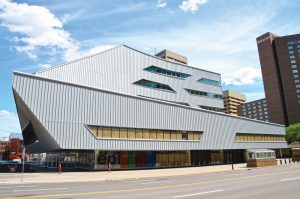Creativity in Design and Execution
A landmark of its time, the Stanley A. Milner Library has lived in the civic heart of downtown Edmonton since 1967. For the expansion and renovation of the monolithic concrete library, the design team was challenged to modernize its Brutalist-style for the 1.2 million visitors it receives every year. Transforming the original concrete façade into a floating, streamlined structure would be no small task. Fast + Epp responded by completely replacing the existing façade with a geometrically complex structure at the north face of the building and incorporating a new lateral system for the building.

The geometrically intricate expansion pushed the design team to the limits of structural inventiveness. Building upgrades were further constrained by existing conditions and financial pressures, emphasized by the challenge to design around delicate areas like an existing theatre – while cantilevering two new floor expansions over 40 feet from the base of the building. To accomplish this feat, the team responded with an interwoven array of three steel trusses. For scale, two of these trusses were almost the length of a city block, while the other truss was over five stories in height. Analyzing the existing structure, Fast + Epp determined that upgrades would be minimal if trusses were tied back to the building columns – one of the few structural elements with additional capacity. Several iterations were required to fine-tune the design, but solutions emerged through this process to address each constraint with efficiency and elegance.
To enhance visibility and brighten up spaces throughout the library, large openings were cut into the floors of the existing structure. This proved to be a distinctively intricate challenge, compounded by missing original structural drawings of several critical floors. Nevertheless, ingenuity between the limited information available, complex site investigations, and creative use of the existing structure made these openings possible.
An architectural feature unique to the building was the visually lightweight reading ramp. This structure underwent several design iterations to achieve the architectural slenderness desired while also meeting serviceability requirements for vibration – allowing a space that simultaneously accommodated people’s movements and the need for undisturbed stillness for reading. To dampen the ramp’s vibration, Fast + Epp engaged all aspects of the new and existing structure, utilizing the truss, two floors of structure, and hangers from the new concrete beams integrated with the existing concrete.
The existing building’s lateral system, built in the 1960s, was grossly deficient by modern code standards. Fast + Epp introduced a completely new lateral system to the existing concrete structure to address this deficiency. The solution was deceptively simple: a collared connection. This detail made use of readily available materials, such as steel pipe and threaded rod, and was iterated to its final constructible design through a collaborative process with the design teams, City engineers, and the Contractor’s experience.
The collared connection enabled Fast + Epp to harness the additional capacity of the existing concrete columns and allowed for steel braces to keep spaces open and sightlines clear within the floors. A similar idea was used to anchor the steel trusses back to the existing structure. This detail also provided flexibility as the columns were heavily reinforced; anchoring into the existing column was simplified. The anchors could be drilled through the existing spiral ties with confinement provided by the collar.
A cornerstone of Fast + Epp’s design intent was minimizing existing structure and foundation upgrades to reduce construction costs. This resulted in using steel as the material of choice, which was optimized to accommodate the high capacities needed while minimizing structural weight. This also meant that many structural elements served multiple functions. For instance, the steel trusses supported the roof, two floors of concrete, the ramp, ribbons of glazing, and secondary components such as drainage systems.
Flexible solutions and constructability were prioritized to minimize labor. Steel connections were slotted or designed for field modification. Concrete connections had collars or were detailed to minimize investigative work and conflicts with the existing reinforcing. With incomplete drawings, several of these connections became custom details determined concurrently with construction.
While connecting to the existing concrete characterized much of the design and construction strategies, the most significant challenge was engineering the installation of the steel trusses. This required close coordination with the steel suppliers and their engineers. Several truss members were cambered for final loading conditions, which were significantly heavier than the self-weight construction condition.
The steel installers, therefore, had to install curved beams to tight tolerances. Preloading the steel beams and regular construction monitoring was used to track the observed site conditions against modeled values and guide the installation process.
The revitalized library celebrated its grand opening on September 17, 2020. Serving as the main branch of the Edmonton Public Library, the Stanley A. Milner Library receives over 1.2 million visits each year. It is a multipurpose community hub, encompassing expanded reading and public spaces, a Makerspace, a high-tech theatre, a daycare, and more.■
